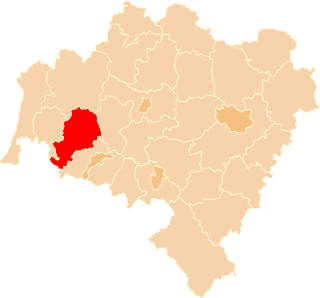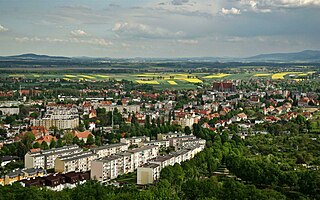
Głogów is a city in western Poland. It is the county seat of Głogów County, in Lower Silesian Voivodeship. Głogów is the sixth largest town in the Voivodeship; its population in 2021 was 65,400. The name of the town derives from głóg, the Polish name for hawthorn.

Lower Silesian Voivodeship in southwestern Poland, is one of the 16 voivodeships (provinces) into which Poland is divided. It covers an area of 19,946 square kilometres (7,701 sq mi), and as of 2019 has a total population of 2,899,986.

Brzeg is a town in southwestern Poland with 34,778 inhabitants and the capital of Brzeg County. It is situated in Silesia in the Opole Voivodeship on the left bank of the Oder river.

Lwówek County is a unit of territorial administration and local government (powiat) in Lower Silesian Voivodeship, south-western Poland. It came into being on January 1, 1999, as a result of the Polish local government reforms passed in 1998. The county covers an area of 709.9 square kilometres (274.1 sq mi). Its administrative seat is the town of Lwówek Śląski, and it also contains the towns of Gryfów Śląski, Mirsk, Wleń and Lubomierz.

Bolesław II the Horned, known also as Bolesław II the Bald, a member of the Silesian Piasts, was High Duke of Poland briefly in 1241 and Duke of Silesia at Wrocław from 1241 until 1248, when the duchy was divided between him and his brothers. After the partition, he ruled the Silesian Duchy of Legnica until his death. The second Mongol raid against Poland, led by Nogai Khan, occurred during his reign.

Głubczyce is a town in Opole Voivodeship in southern Poland, near the border with the Czech Republic. It is the administrative seat of Głubczyce County and Gmina Głubczyce.

Lwówek Śląski is a town in the Lower Silesian Voivodeship in Poland. Situated on the Bóbr River, Lwówek Śląski is about 30 kilometres NNW of Jelenia Góra and has a population of about 9,000 inhabitants. It is the administrative seat of Lwówek Śląski County and of the municipality Gmina Lwówek Śląski.

Gryfów Śląski, simplified to Gryfów, is a historic town in Lwówek Śląski County, Lower Silesian Voivodeship, in south-western Poland. It is the seat of the administrative district (gmina) called Gmina Gryfów Śląski. As of 2019, the town has a population of 6,636. The town is located between Zgorzelec and Jelenia Góra, on the Kwisa river. It lies approximately 16 kilometres (10 mi) south-west of Lwówek Śląski, and 114 kilometres (71 mi) west of the regional capital Wrocław.

Strzegom is a town in Świdnica County, Lower Silesian Voivodeship, in south-western Poland. It is the seat of the Gmina Strzegom administrative district (gmina). It lies approximately 15 kilometres (9 mi) north-west of Świdnica, and 52 kilometres (32 mi) west of the regional capital Wrocław.

Milicz is a town in Lower Silesian Voivodeship, in west-central Poland. It is the seat of Milicz County and of Gmina Milicz, part of the larger Wrocław metropolitan area.

Nowogrodziec is a town in Bolesławiec County, Lower Silesian Voivodeship, in south-western Poland. It is the seat of the administrative district called Gmina Nowogrodziec. It lies on the east bank of the Kwisa river south of the Lower Silesian Wilderness, approximately 15 kilometres (9 mi) south-west of Bolesławiec, and 116 kilometres (72 mi) west of the regional capital Wrocław.

Twardogóra is a historic town in Oleśnica County, Lower Silesian Voivodeship, in south-western Poland. It is the seat of the administrative district (gmina) called Gmina Twardogóra. It lies approximately 20 kilometres (12 mi) north of Oleśnica, and 40 kilometres (25 mi) north-east of the regional capital Wrocław.

Proszówka is a village in the administrative district of Gmina Gryfów Śląski, within Lwówek Śląski County, Lower Silesian Voivodeship, in south-western Poland.
Gmina Lubomierz is an urban-rural gmina in Lwówek Śląski County, Lower Silesian Voivodeship, in south-western Poland. Its seat is the town of Lubomierz, which lies approximately 13 kilometres (8 mi) south-west of Lwówek Śląski, and 108 kilometres (67 mi) west of the regional capital Wrocław.

Gmina Lwówek Śląski is an urban-rural gmina in Lwówek Śląski County, Lower Silesian Voivodeship, in south-western Poland. Its seat is the town of Lwówek Śląski, which lies approximately 102 kilometres (63 mi) west of the regional capital Wrocław.
Gmina Wleń is an urban-rural gmina in Lwówek Śląski County, Lower Silesian Voivodeship, in south-western Poland. Its seat is the town of Wleń, which lies approximately 13 kilometres (8 mi) south-east of Lwówek Śląski, and 97 kilometres (60 mi) west of the regional capital Wrocław.
Klecza is a village in the administrative district of Gmina Wleń, within Lwówek Śląski County, Lower Silesian Voivodeship, in south-western Poland. It lies approximately 3 kilometres (2 mi) west of Wleń, 13 kilometres (8 mi) south of Lwówek Śląski, and 100 kilometres (62 mi) west of the regional capital Wrocław.

The Silesian Piasts were the elder of four lines of the Polish Piast dynasty beginning with Władysław II the Exile (1105–1159), eldest son of Duke Bolesław III of Poland. By Bolesław's testament, Władysław was granted Silesia as his hereditary province and also the Lesser Polish Seniorate Province at Kraków according to the principle of agnatic seniority.

Duchy of Jawor was one of the Duchies of Silesia and medieval Poland established in 1274 as a subdivision of the Duchy of Legnica. It was ruled by the Silesian Piasts, with its capital at Jawor in Lower Silesia.

The Duchy of Löwenberg or Duchy of Lwówek was one of the Duchies of Silesia and medieval Poland established in 1281 as a division of the Duchy of Jawor. The duchy of Lwówek was ruled by the Silesian Piast, Bernard the Lightsome, with its capital at Lwówek Śląski in Lower Silesia. It was the southwesternmost duchy of Poland at the time.

























